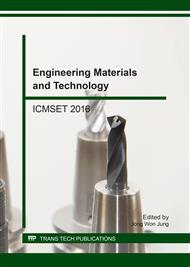[1]
S. Mallick, P. Kar, B. B. Khatua, Morphology and properties of nylon 6 and high density polyethylene blends in presence of nanoclay and PE-g-MA, J. Appl. Polym. Sci. 123(3) (2012) 1801-1811.
DOI: 10.1002/app.34648
Google Scholar
[2]
M. Yousfi, J. Soulestin, B. Vergnes, M. -F. Lacrampe, P. Krawczak, Compatibilization of immiscible polymer blends by organoclay: Effect of nanofiller or organo-modifier?, Macromol. Mater. Eng. 298(7) (2013) 757-770.
DOI: 10.1002/mame.201200138
Google Scholar
[3]
T. Nazari, H. Garmabi, Effect of organoclays on the rheological and morphological properties of poly(acrylonitrile-butadiene-styrene)/poly(methyl methacrylate)/clay nanocomposites, Polym. Compos. 33(11) (2012) 1893-(1902).
DOI: 10.1002/pc.22329
Google Scholar
[4]
T. Nazari, H. Garmabi, A. Arefazar, Effect of clay modification on the morphology and the mechanical/physical properties of ABS/PMMA blends, J. Appl. Polym. Sci. 126(5) (2012) 1637-1649.
DOI: 10.1002/app.36953
Google Scholar
[5]
S. S. Ray, M. Bousmina, Compatibilization Efficiency of organoclay in an immiscible polycarbonate/poly(methyl methacrylate) blend, Macromol. Rapid Commun. 26(6) (2005) 450-455.
DOI: 10.1002/marc.200400586
Google Scholar
[6]
Y. Li, H. Shimizu, Co-continuous polyamide 6 (PA6)/acrylonitrile-butadiene-styrene (ABS) nanocomposites, Macromol. Rapid Commun. 26(9) (2005) 710-715.
DOI: 10.1002/marc.200400654
Google Scholar
[7]
P. Choudhary, S. Mohanty, S. K. Nayak, L. Unnikrishnan, Poly(L-lactide)/polypropylene blends: Evaluation of mechanical, thermal, and morphological characteristics, J. Appl. Polym. Sci. 121(6) (2011) 3223-3237.
DOI: 10.1002/app.33866
Google Scholar
[8]
A. Hasook, S. Tanoue, Y. Iemoto, Characterization and mechanical properties of poly(lactic acid)/poly(e-caprolactone)/organoclay nanocomposites prepared by melt compounding, Polym. Eng. Sci. 46(8) (2006) 1001-1007.
DOI: 10.1002/pen.20579
Google Scholar
[9]
S. Wacharawichanant, P. Amorncharoen, R. Wannasirichoke, Effects of compatibilizers on morphology and properties of polyoxymethylene/polypropylene blends, Polymer-Plastics Technol. Eng. 54(13) (2015) 1349-1357.
DOI: 10.1080/03602559.2014.996903
Google Scholar
[10]
T. Baouz, F. Rezgui, U. Yilmazer, Ethylene-methyl acrylate-glycidyl methacrylate toughened poly(lactic acid) nanocomposites, J. Appl. Polym. Sci. 128(5) (2013) 3193-3204.
DOI: 10.1002/app.38529
Google Scholar


